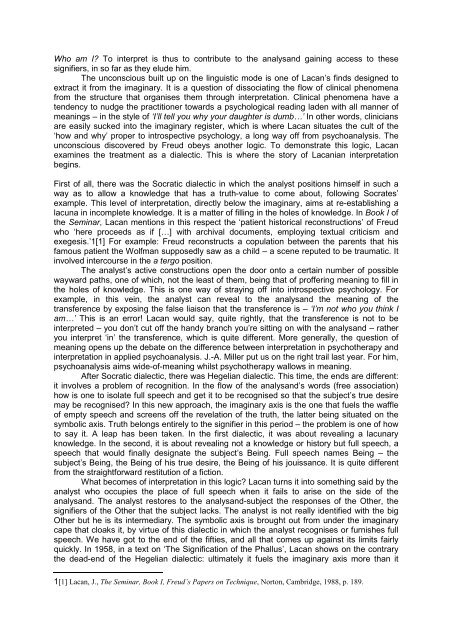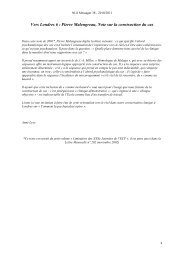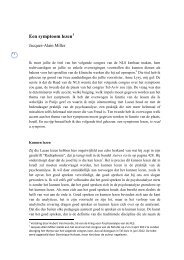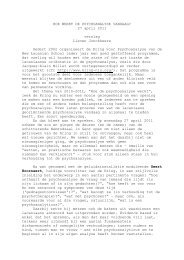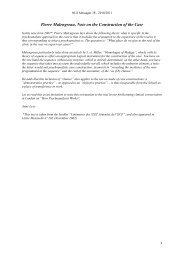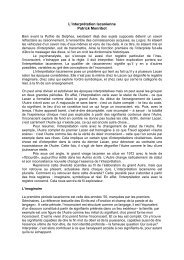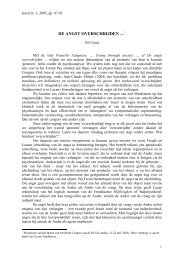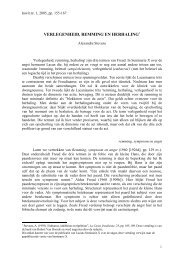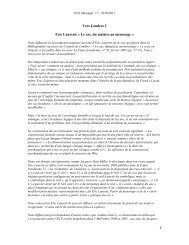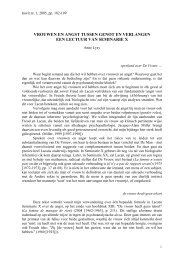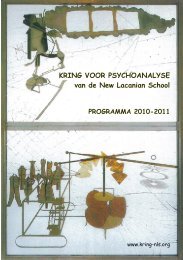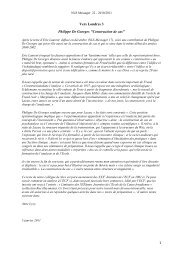Lacanian Interpretation Patrick Monribot - Psychoanalyse Lacan ...
Lacanian Interpretation Patrick Monribot - Psychoanalyse Lacan ...
Lacanian Interpretation Patrick Monribot - Psychoanalyse Lacan ...
Create successful ePaper yourself
Turn your PDF publications into a flip-book with our unique Google optimized e-Paper software.
Who am I? To interpret is thus to contribute to the analysand gaining access to these<br />
signifiers, in so far as they elude him.<br />
The unconscious built up on the linguistic mode is one of <strong>Lacan</strong>’s finds designed to<br />
extract it from the imaginary. It is a question of dissociating the flow of clinical phenomena<br />
from the structure that organises them through interpretation. Clinical phenomena have a<br />
tendency to nudge the practitioner towards a psychological reading laden with all manner of<br />
meanings – in the style of ‘I’ll tell you why your daughter is dumb…’ In other words, clinicians<br />
are easily sucked into the imaginary register, which is where <strong>Lacan</strong> situates the cult of the<br />
‘how and why’ proper to introspective psychology, a long way off from psychoanalysis. The<br />
unconscious discovered by Freud obeys another logic. To demonstrate this logic, <strong>Lacan</strong><br />
examines the treatment as a dialectic. This is where the story of <strong><strong>Lacan</strong>ian</strong> interpretation<br />
begins.<br />
First of all, there was the Socratic dialectic in which the analyst positions himself in such a<br />
way as to allow a knowledge that has a truth-value to come about, following Socrates’<br />
example. This level of interpretation, directly below the imaginary, aims at re-establishing a<br />
lacuna in incomplete knowledge. It is a matter of filling in the holes of knowledge. In Book I of<br />
the Seminar, <strong>Lacan</strong> mentions in this respect the ‘patient historical reconstructions’ of Freud<br />
who ‘here proceeds as if […] with archival documents, employing textual criticism and<br />
exegesis.’1[1] For example: Freud reconstructs a copulation between the parents that his<br />
famous patient the Wolfman supposedly saw as a child – a scene reputed to be traumatic. It<br />
involved intercourse in the a tergo position.<br />
The analyst’s active constructions open the door onto a certain number of possible<br />
wayward paths, one of which, not the least of them, being that of proffering meaning to fill in<br />
the holes of knowledge. This is one way of straying off into introspective psychology. For<br />
example, in this vein, the analyst can reveal to the analysand the meaning of the<br />
transference by exposing the false liaison that the transference is – ‘I’m not who you think I<br />
am…’ This is an error! <strong>Lacan</strong> would say, quite rightly, that the transference is not to be<br />
interpreted – you don’t cut off the handy branch you’re sitting on with the analysand – rather<br />
you interpret ‘in’ the transference, which is quite different. More generally, the question of<br />
meaning opens up the debate on the difference between interpretation in psychotherapy and<br />
interpretation in applied psychoanalysis. J.-A. Miller put us on the right trail last year. For him,<br />
psychoanalysis aims wide-of-meaning whilst psychotherapy wallows in meaning.<br />
After Socratic dialectic, there was Hegelian dialectic. This time, the ends are different:<br />
it involves a problem of recognition. In the flow of the analysand’s words (free association)<br />
how is one to isolate full speech and get it to be recognised so that the subject’s true desire<br />
may be recognised? In this new approach, the imaginary axis is the one that fuels the waffle<br />
of empty speech and screens off the revelation of the truth, the latter being situated on the<br />
symbolic axis. Truth belongs entirely to the signifier in this period – the problem is one of how<br />
to say it. A leap has been taken. In the first dialectic, it was about revealing a lacunary<br />
knowledge. In the second, it is about revealing not a knowledge or history but full speech, a<br />
speech that would finally designate the subject’s Being. Full speech names Being – the<br />
subject’s Being, the Being of his true desire, the Being of his jouissance. It is quite different<br />
from the straightforward restitution of a fiction.<br />
What becomes of interpretation in this logic? <strong>Lacan</strong> turns it into something said by the<br />
analyst who occupies the place of full speech when it fails to arise on the side of the<br />
analysand. The analyst restores to the analysand-subject the responses of the Other, the<br />
signifiers of the Other that the subject lacks. The analyst is not really identified with the big<br />
Other but he is its intermediary. The symbolic axis is brought out from under the imaginary<br />
cape that cloaks it, by virtue of this dialectic in which the analyst recognises or furnishes full<br />
speech. We have got to the end of the fifties, and all that comes up against its limits fairly<br />
quickly. In 1958, in a text on ‘The Signification of the Phallus’, <strong>Lacan</strong> shows on the contrary<br />
the dead-end of the Hegelian dialectic: ultimately it fuels the imaginary axis more than it<br />
1[1] <strong>Lacan</strong>, J., The Seminar, Book I, Freud’s Papers on Technique, Norton, Cambridge, 1988, p. 189.


